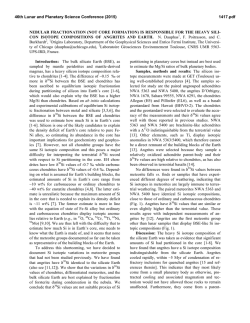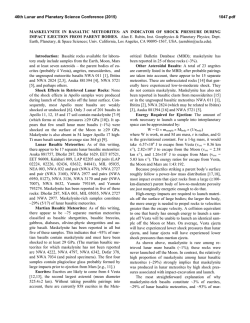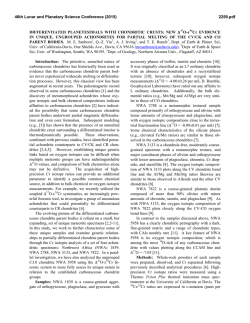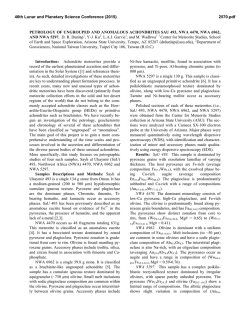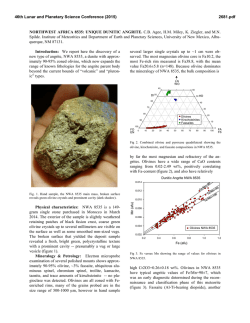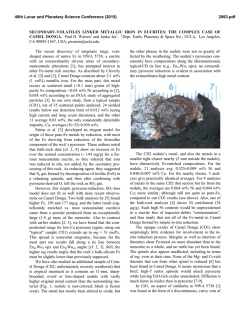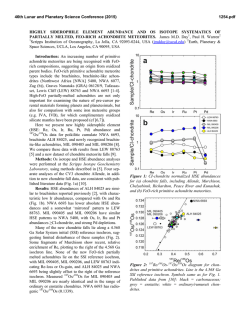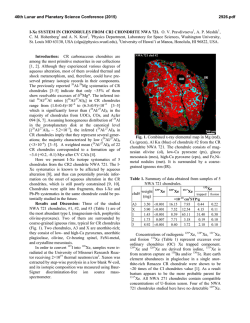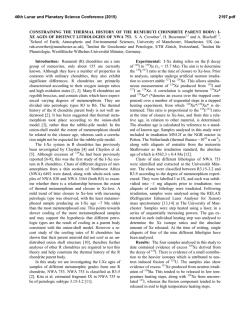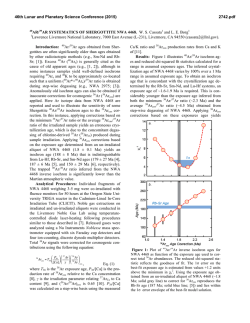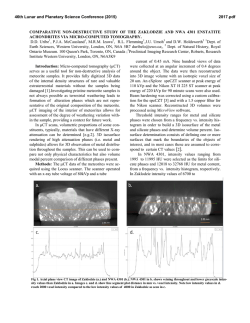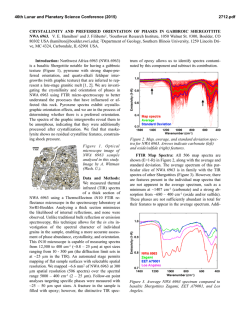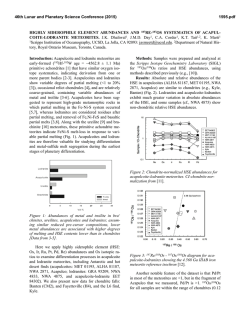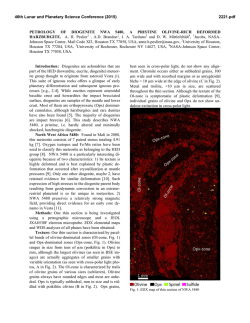
NWA 5363/NWA 5400 AND THE EARTH: ISOTOPIC TWINS OR
46th Lunar and Planetary Science Conference (2015) 2732.pdf NWA 5363/NWA 5400 AND THE EARTH: ISOTOPIC TWINS OR JUST DISTANT COUSINS? C. Burkhardt1, N. Dauphas1, H. Tang1,2, M. Fischer-Gödde3, L. Qin4, J. H. Chen6, A. Pack5, S. S. Rout7, P. R. Heck7, D. A. Papanastassiou 6,8. 1Origins Laboratory, Department of the Geophysical Sciences and Enrico Fermi Institute, The University of Chicago, IL 60637, USA ([email protected]). 2Department of Earth, Planetary, and Space Sciences, UCLA, Los Angeles, CA 90095-1567. 3Institut für Planetologie, WWU Münster, Germany. 4School of Earth and Space Science, USTC, Hefei, Anhui, 230026, PR China 5Geowissenschaftliches Zentrum, Abteilung Isotopengeologie, Goldschmidtstraße 3, 37077 Göttingen, Germany. 6Jet Propulsion Laboratory, Pasadena, USA. 7 Pritzker Center for Meteoritics and Polar Studies, The Field Museum, Chicago, USA. 8Division of Geological and Planetary Sciences, Caltech, USA. Introduction: The notion that the chemical composition of terrestrial planets can be made by mixing primitive chondrites in various proportions forms the backbone of much of today’s planetary geochemistry. A lingering issue, however, is that the meteorites that are most often considered for explaining the chemical composition of the Earth [1] also display isotopic anomalies relative to terrestrial rocks, and so they cannot be viable building blocks for the Earth [2-7]. The only meteorite group that approximately matches the terrestrial composition are enstatite chondrites [8,9], but these meteorites also have low Mg/Si and δ30Si values, so that one would have to assume unfeasibly large amounts of Si hidden in the core or the mantle [10,11]. These observations urge the use of caution when taking chondrites as proxies for the bulk isotopic composition of the terrestrial planets. For example, using ordinary chondrites as proxy for the 142Nd/144Nd of the bulk Earth might lead to incorrect interpretations of the 142 Nd rock record to determine accretion and differentiation timescales of the Earth [12]. Likewise, taking the Si isotope composition of ordinary and carbonaceous chondrites as representative for the bulk Earth may lead to wrong assumptions about the Earth's Mg/Si ratio and the amount of Si in Earth's core [13]. If known chondrite types are not always good isotopic proxies for the planetary materials that formed the Earth, are there any meteorites that are? The ungrouped (paired) primitive achondrites NWA 5363 and NWA 5400 are relatively oxidized (~IW-1), metalbearing ultramafic stones with terrestrial O and Cr isotope compositions [14-16]; thus they may represent primitive samples of the elusive terrestrial reservoir. As part of our ongoing effort to better constrain the isotopic composition of the bulk Earth and the genetic relations of meteorites and the Earth-forming reservoir we present here a comprehensive petrographic, elemental and multi-isotopic (O, Ca, Ti, Cr, Ni, Mo, Ru, W) study of the NWA 5363/NWA 5400 meteorites, as well as isotope data for the chondrites Pillistfer (EL6), Allegan (H6) and Allende (CV3). Our results do not support the idea of a common reservoir for the NWA 5363/NWA 5400 parent body and the Earth. Analytical Methods: About 3-5 gram pieces of the meteorite samples were cleaned with grinding paper and ultrasonication in methanol, and subsequently crushed and powdered in an agate mortar at the Origins Lab. Aliquots of the powders were distributed to the collaborators and digested and processed together with a terrestrial rock standard (BHVO-2 or DTS-2) according to previously established methods. Bulk major and trace element analysis were obtained through SARM in Nancy, France. Oxygen was analyzed by laser-fluorination GC-Gas-MS in Göttingen, Ca and Cr by TIMS at JPL and USTC, Ti, Ni, Mo, Ru and W by MC-ICP-MS in Chicago and Münster. Epoxy-mounted thick-sections of NWA 5363 and NWA 5400 were investigated by SEM at the Field Museum. Results: Petrography. The texture of NWA 5363 and NWA 5400 is granuloplastic with triple junctions. In both meteorites olivine (Fa 30) is dominant (~80%) followed by Ca-poor pyroxene (En 73Fs25Wo2), Ca-rich pyroxene (En45Fs10Wo45), and minor chlorapatite, troilite, chromite (Cr/Cr+Al=82), (oxidized) FeNimetal grains and traces of plagioclase (Ab 72An27Or1). Both meteorites show significant terrestrial alteration (Fe-oxide veins), with NWA 5363 being better preserved than NWA 5400. Major and trace elements. Relative to chondritic abundances, the NWA samples are depleted in lithophile Al, Na, K, Ti, HFSEs and REEs, thus showing clear evidence for the extraction of a partial silicate melt, consistent with the almost complete absence of plagioclase. Molybdenum, W and the HSE on the other hand show strong enrichments relative to chondrites. Elements tracing desert weathering like U and Ba are significantly enriched relative to chondrites, with NWA 5400 showing the higher enrichments. Isotopic compositions: Oxygen. The δ18O and Δ17O values of NWA 5363 (5.7±0.7; -0.096±0.020; 2σ) and NWA 5400 (6.7±0.7; -0.139±0.032) are within uncertainty indistinguishable from the BHVO-2 (5.7± 0.7; -0.088±0.032) and San Carlos olivine (5.3±0.7; -0.102±0.012) standard measurements. These results confirm earlier O isotope measurements that found no Δ17O anomalies in the 46th Lunar and Planetary Science Conference (2015) NWA 5363/NWA 5400 samples [15-17]. On a 1σ level the Δ17O values of NWA 5363 and NWA 5400 are distinct. This most likely reflects the effects of desert alteration on NWA 5400. Our measurement of Pillistfer confirms a significant (~50 ppm) difference in Δ 17O between enstatite chondrites and the Earth, leaving NWA5363 as the only known meteorite with identical Δ17O as the Earth. Calcium. Our data shows a common, and relative to the Earth, slightly anomalous Ca isotope composition of NWA 5363 and NWA 5400 (ε 48Ca = -0.55±0.22 and -0.48±0.40). Titanium. The Ti isotope compositions of NWA 5363 and NWA 5400 are within uncertainty identical (ε50Ti = -0.95±0.17 and -1.01±0.13) to each other, but significantly different from the Earth. Chromium. New Cr data will be presented at the conference. Shukulyukov et al. [16] reported a terrestrial ε54Cr of 0.07±0.11 for NWA 5400. Nickel. The Ni isotope compositions of NWA 5363 and NWA 5400 are indistinguishable from each other (ε64Ni = 0.05±0.19 and 0.03±0.08) and within uncertainty identical to the terrestrial composition (ε 64Ni=0). Molybdenum. NWA 5363 is characterized by a small deficit in s-process Mo (ε92Mo=0.53±0.22), similar to ordinary chondrites and possibly enstatite chondrites. Ruthenium. Like for Mo, the Ru isotope composition of NWA 5363 exhibits a s-process deficit (ε100Ru= -0.34±0.13) similar to ordinary chondrites. Tungsten. NWA 5363 and NWA 5400 exhibit identical and highly unradiogenic ε182W values of -3.26 ±0.08 and -3.18±0.08. Together with their low 180 Hf/184W (0.02), this equates to a two-stage model age of Hf/W fractionation from a chondritic reservoir of 1.2±0.5 Ma after CAI. Discussion: Our new petrographic, elemental and isotopic data confirm that NWA 5363 and NWA 5400 are paired primitive achondritic meteorites from an early-formed relatively oxidized asteroidal parent body. The mineral assemblage is interpreted as representing a restite after partial melting and extraction of a small amount of silicate melt from a fertile (chondritic) source rock within ~1.5 Myr of the start of the solar system. The high concentrations of refractory siderophile elements (Mo, W, HSE) in the restite requires the presence of metal during silicate melt extraction and indicates the absence of a planetary-wide metal-silicate fractionation event on the NWA 5363/ NWA 5400 parent body. The O, Cr, and Ni isotopic compositions of NWA 5363/NWA 5400 are indistinguishable from the terrestrial isotope abundances, suggesting a close genetic relationship between the nebular reservoirs from which 2732.pdf Fig. 1. O, Ca, Ti, Cr, Ni, Mo and Ru isotope data of the NWA 5363/NWA 5400 ungrouped achondrites and selected chondrite groups. Contrasting earlier reports our multi-isotopic investigation reveals that NWA 5363/5400 is not sampling the Earth-forming reservoir. Data sources: this study and [4,15] for Cr. the NWA parent body and the Earth accreted. In fact, the NWA 5363/NWA 5400 meteorites are currently the only known extraterrestrial materials with an O isotopic composition identical to the bulk Earth. However, our new Ca, Ti, Mo and Ru isotope data also reveal significant differences between the isotopic makeup of NWA 5363/NWA 5400 and the Earth. Thus, although the NWA 5363/NWA 5400 meteorites are highly interesting samples of a unique partially differentiated asteroidal parent body, they are not sampling the terrestrial planetary reservoir and are not the Rosetta stones to decipher the isotopic composition of the bulk Earth. References: [1] Allègre C. J. et al. (1995) EPSL, 134, 515-526. [2] Calyton R. N. (1993) AREPS 21, 115. [3] Dauphas N. et al. (2002) ApJ, 565, 640-644. [4] Trinquier A. et al. (2009) Science, 324, 374-376. [5] Burkhardt C. et al. (2011) EPSL, 312, 390-400. [6] Chen J. H. et al. (2010) GCA, 74, 3851–3862. [7] Herwartz D. et al. (2014) Science, 344, 1146-1150. [8] Warren P. H. (2011) EPSL, 311, 93-100. [9] Dauphas N. et al. (2014) EPSL, 407, 96-108. [10] Fitoussi C. and Bourdon B. (2012) Science, 335, 1477-1480. [11] Zambardi T. et al. (2013) GCA, 121, 67-83. [12] Kleine T. et al. (2013) LPS XLIV, Abstract #3020. [13] Dauphas N. et al. (2015) LPS XLVI, Abstract #1417. [14] Irving A. J. et al. (2009) LPS XL, Abstract #2332. [15] Shukolyukov A. et al. (2010) LPS XLI, Abstract #1492. [16] Larouci N. et al. (2013) 76th Met. Soc. Meeting, Abstract #5185.
© Copyright 2026

